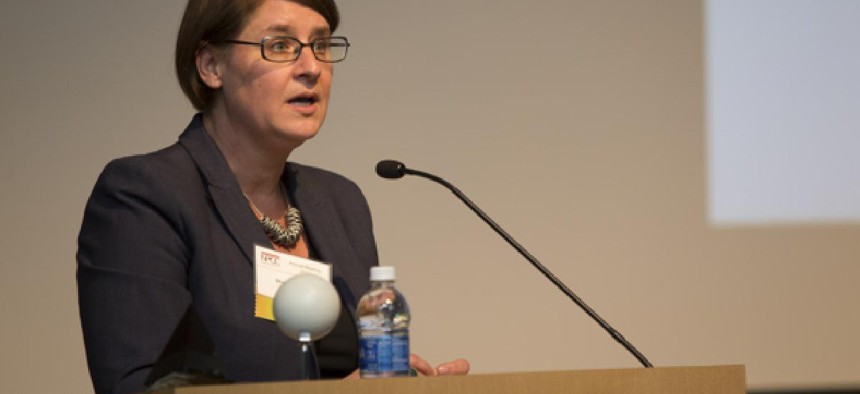NPCC’s new strategic plan calls for nonprofits to become agents of change

With a new mission and strategic plan, the Nonprofit Coordinating Committee of New York is looking to equip its membership for a more activist role – both to help counter problematic social policies and to help create an operating environment where nonprofits are stronger and more sustainable.
“You’ll see us be a little bit louder … and a little bit more forceful in our opinions about things,” NPCC’s Executive Director Sharon Stapel said. “You’ll see more advocacy on the state and local level and if necessary on the federal level.”
The organization’s new mission statement, shortened from 44 words to 12, debuts a simpler and clearer goal: NPCC helps New York nonprofits thrive to build better communities for all.
NPCC rolled out these new elements during its annual meeting May 15 at the CUNY Graduate Center. In many ways it represents a return to the organization’s roots. According to its website, NPCC was founded in 1984 to contest the city’s attempt to do away with the charitable property tax exemption. After defeating that proposal, they worked to achieve other tax exemptions for nonprofits.
The need to create a more sustainable sector is behind this most recent push for more advocacy and civic engagement. Its new strategic plan was developed as a result of receiving feedback from the organization’s members. They called on NPCC to “convene, organize and lead the sector” with initiatives that will strengthen nonprofits, Stapel said.
“Building a movement” is one of the plan’s stated goals – to be achieved primarily through campaigns that address topics such as compliance and regulation issues, electioneering issues and tax reform, along with campaigns that show the value of the sector as a whole. NPCC will also provide nonprofits with educational resources that align with the goal.
For example, to prepare their nearly 1,500 member organizations - 67 percent of whom have a budget under one million dollars – to take a more active role in influencing legislative and electoral politics, each attendee’s bag included a jump drive with materials from The Advocacy Institute. Their documents defined legislative advocacy and lobbying and explained what kinds of civic engagement 501(c)(3) and 501(c)(4) nonprofits are permitted to engage in. Other inclusions listed the names of city and state governing officials with State Senate and Assembly members grouped by their legislative conferences – and noted important dates when nonprofits could most directly impact legislative and budget processes.
NPCC’s stronger advocacy stance aligns with similar work by other umbrella organizations such as the Federation of Protestant Welfare Agencies and the Human Services Council; but Stapel doesn’t expect there will be much overlap.
“NPCC will be taking the lead on issues that impact the sector as a whole,” Stapel said in a written statement to New York Nonprofit Media. NPCC’s membership includes human services, health, arts and civic engagement organizations along with both charities and foundations. “Where the issues are squarely impacting only one subsector, such as human services, we will follow HSC’s lead as the umbrella organization for that subsector.”
The strategic planning process included conducting the organization’s first needs assessment, followed by an environmental scan and an open house to solicit feedback from members. Planning began in 2016, before the change in presidential administrations portended an even more challenging climate for nonprofits and their causes. By the time planning was complete, the resulting document seemed all the more timely. The three-year plan will go into effect in October of this year.
The annual meeting closed with a panel entitled, “Building Members and Building Movements: Nonprofits As Agents of Change.”
Panelist Maggie Williams of The Advocacy Institute pointed out that nonprofits can affect change by joining an issue-based coalition or joining a legislative campaign. Legislative campaigns can be prohibitively expensive and time consuming Williams warned, though they may be worthwhile if the experience can also be leveraged to significantly benefit the nonprofit.
“Can you, with legislative advocacy, actually be building your institutional memory and building your institutional brand?” Williams said.
Panelists also encouraged nonprofits to use advocacy efforts as an opportunity to provide training and leadership development opportunities directly to their consumers – while being mindful of how participating in advocacy could affect them.
“We might be asking people who are suffering injustices and are directly impacted, to actually encounter more injustice as they push back for legislative change,” Williams said.
Stapel called on “funder nonprofits,” such as charities and foundations, to see themselves as part of the same nonprofit sector as service agencies and encouraged funder nonprofits to take up their responsibility to support advocacy.
“This is a different time for all of us. This comes on the heels of an economic downturn, that came on the heels of an already dysfunctional business model between many nonprofits and government funders, so we are sort of layering problems,” Stapel said.
“In order for us to get to the root of what all of this is, and in order for us to get to the core so that we know how to move forward … we need to be able to recognize who we are … and we need to see that we have a common goal,” Stapel said.
